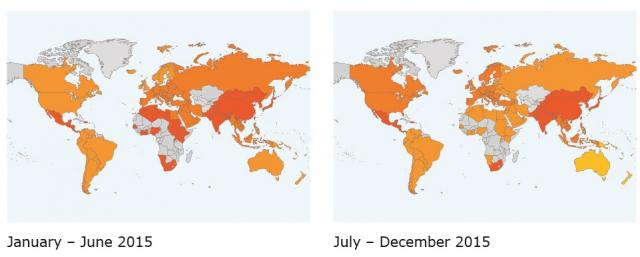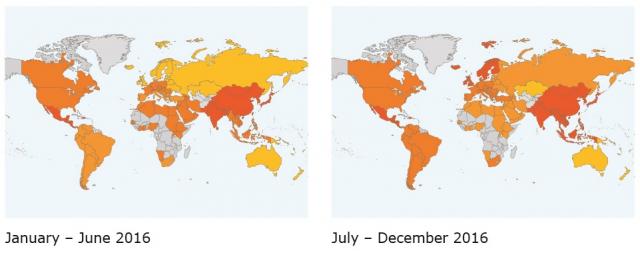Changes in mycotoxin risks
By Paula Kovalsky, Product Manager, Mycotoxin Risk Management BIOMIN Holding GmbH
Mycotoxins can be present on a crop in the field or can affect stored grain (Bennett et al., 2003). Many mycotoxin-producing fungi are able to produce more than one type of mycotoxin. In addition, several types of fungi can affect a single crop leading to the presence of multiple mycotoxins. In all of our surveys throughout the 13 years, the percentage of samples with more than one mycotoxin has always been higher than the percentage of samples containing only one mycotoxin (Streit et al., 2013). It is well known that mycotoxins can cause severe symptoms of toxicity at high doses and beyond the obvious visual symptoms, there is a high cost to the livestock industry in each year (Bryden, 2012).
The BIOMIN World Mycotoxin Survey is the longest running survey of animal feeds for toxins produced by fungi. It provides an overview on the incidence of aflatoxins (Afla), zearalenone (ZEN), deoxynivalenol (DON), fumonisins (FUM), T-2 toxin (T-2) and ochratoxin A (OTA) in the primary components used for feed. Results are assessed according to the risks posed to livestock and are based on the proportion of samples for which at least one mycotoxin was above a risk threshold.
In 2016, 88% of over 16 500 samples tested contained at least one mycotoxin and co-occurrence was observed in 64% of samples. Almost two-thirds (62%) of the feed materials sampled had at least one of the major mycotoxins present at a level that could pose a risk to animal health or performance. Results show that all regions are affected by mycotoxins with DON and FUM at highest prevalence around the world at 68% and 61%, respectively. In addition, ZEN was present in almost half of all samples tested.
Fluctuations in mycotoxin contamination can be observed from year to year and can be explained in detail when the data is broken down into six-month periods. Figure 1 shows an overview of the risk assessment for the period from January to June in 2015 and 2016.



Changes in risk for half year from 2015 to 2016 indicate the changes that happen with the main crop harvests, particularly in the Northern Hemisphere. Very high contamination that was present in European crops in the 2014 harvest are reflected in the early 2015 results. Similarly, early 2016 results in the Northern Hemisphere show the relatively reduced risk in the 2015 harvest. In the second half of 2016, the risk level increased in South-East Asia (from 70% to 76%), East Asia (84% to 88%), Oceania (8% to 24%), South America (from 37% to 74%) and South Africa (from 45% to 73%).
Regional insights
In 2016, the South American cereal and corn harvests had lower occurrence of detected mycotoxins than usual, but the levels of DON in the positive samples was a cause for concern. Soybeans are normally considered a low mycotoxin risk, but with high rainfall at harvest, as seen in some regions of South America this year, the risk can be just as high as in a susceptible crop such as corn. Other mycotoxin risks in grains can include ergot alkaloids. In addition, South American finished feed revealed that FUM and DON posed the greatest risk in that continent. The rise in their prevalence included sharp increases in samples with very high contamination.
Asia has seen an increase in 2016 in the overall proportion of at risk samples compared with the previous year. The rise has been seen particularly in Eastern Asia and South East Asia. South Asia which was already at a very high risk level in 2015 remains at a similar level in 2016. In South Asia, the highest OTA prevalence was observed at 82%. Aflatoxins continue to represent a significant risk in South Asia and South-East Asia.
In Africa, 42% of the samples tested were contaminated with Afla at an average level of 52 ppb. Almost one-quarter of these samples contain aflatoxins at levels that represent a significant risk. Fumonisins were present in 79% of samples and more than one-third of these samples are above the risk threshold.
Zearalenone and fumonisins were most commonly found in the Middle East and one-third of samples of this region were contaminated with DON. At least one mycotoxin was detected in 85% of Middle East samples and 66% had co-occurrence.
Conditions favoring mycotoxin production
The extent to which cereals and corn are infected by fungal disease is largely related to weather conditions during flowering and the lead up to harvest. This is particularly true for mycotoxins that are produced by plant diseases, such as Fusarium ear rot of corn and Fusarium head blight of cereals. In addition, drought can compromise grain quality leading increasing the chance of mycotoxin producing fungi affecting grain in storage. Temperature highly affects the production of mycotoxins e.g. fumonisins tend to be produced more in warmer conditions, while T-2 toxin and DON production is generally higher in cooler conditions (Bennett et al., 2003).
Mycotoxin cocktails pose danger to the animal
Fusarium graminearum in both cereals and corn is the main producer of DON and ZEN, two of the most common mycotoxins worldwide. Under the right cool conditions, related fungi (predominantly Fusarium sporotrichioides, F. poae and F. langsethiae) can produce T-2 toxin, a type A trichothecene which typically occurs at lower levels but is more potent than type B trichothecenes (such as DON). On corn, Fusarium verticillioides is also commonly present and produces fumonisins. ZEN, T-2 and FUM are all known to interact with DON in a way that the effect of DON e.g. on the gut wall or on the immune system, can get worse (Maresca, 2013).
Toxicological interactions between mycotoxins may enhance the toxicological effects when there are low levels of mycotoxins in the feed. There are three categories: 1) additive (no interaction as expected), 2) synergistic (interaction resulting in greater effect than expected) and 3) antagonistic effects (interaction leading to a lower effect than expected). It is also common for low levels of mycotoxins below regulatory or guidance levels to have a negative impact on animal health and performance (Grenier et al., 2016).
Strategy to manage multiple mycotoxins
Multi-mycotoxin occurrences continue to be a global threat. Constant monitoring and continual research on the prevention and mitigation of mycotoxin contamination are therefore necessary. The first steps towards preventing the negative effects of these harmful substances are the implementation of good agricultural practices, proper storage conditions and the implementation of strategies that are scientifically proven to address the range of mycotoxin threats present. For most of the major mycotoxins including the common threats of DON (and other trichothecenes) and ZEN, effective biotransformation is required on top of a reliable binder for aflatoxin and ergot alkaloids.
References
Bennett W.; Klich M. 2003. Mycotoxins, J. Clin. Microbiol. Rev., 16 (3): 497-516.
Bryden, W. L. 2012. Mycotoxin contamination of the feed supply chain: Implications for animal productivity and feed security. Anim. Feed Sci. Technol., 173: 134-158.
Grenier B.; Dohnal I.; Shanmugasundaram R.; Eicher S. D.; Selvaraj R. K.; Schatzmayr G.; Applegate T. J. 2016. Susceptibility of broiler chickens to coccidiosis when fed subclinical doses of Deoxynivalenol and Fumonisins—Special emphasis on the immunological response and the mycotoxin interaction, Toxins, 8 (8): 231.
Maresca, M. 2013. From the gut to the brain: journey and pathophysiological effects of the food-associated trichothecene mycotoxin deoxynivalenol, Toxins, 5: 784-820.
Streit, E.; Naehrer, K.; Rodrigues, I.; Schatzmayr, G. 2013. Mycotoxin occurrence in feed and feed raw materials worldwide: long-term analysis with special focus on Europe and Asia., J. Sci. Food Agric., 93: 2892-2899.

